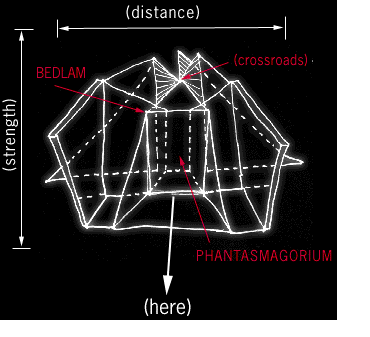reading blast5drama
by
Alex Galloway
During the years 1989--1994 (I am referring to the United States) there was a certain way of thinking that endorsed the emergence of hybridization in technology and culture. These are the years when hypertext entered the academy, when online work entered the art world, and when cultural production as a whole shifted due to a certain new stress: the digital transfer of information.
The current online x-travaganza at the X-Art Foundation is indicative of this textual shift. Blast5drama, staged concurrently with events at Sandra Gering Gallery (NYC) and two MOOs, is a broad amalgamation of material including visuals, theory bites, verse, calls for participation, and offline event documentation. Like any good site it is a nexus of material whose hypertextual borders are free and open. Although I was not present at any of the New York events, let me comment here on blast5drama's internet accessible content.
Its opening page is perfect: elegant, good layout, sharp graphics, smart lo-band animation, great menu categories in the header. The visual is a set of line drawings of multidimensional spaces, the sort of quick drawings that you might find in an architect's sketch book. They are white on black, annotated with diagrammatic phrases and arrows, and scroll slowly by as frames of an animated gif. They are (literally) the model for this piece. And they gesture toward the site's content.
Go to "backstage" first. It gives good background theory for the project. Glance at the nicely rendered but impenetrable and dead-linked "poster" (complete with customized, nearly legible font), then take a gander at the "call for manifestoes." All soapbox revolutionaries are welcome.
Past this lie the "Crossroads," a paragraph of text filled with links that forms the core of the site. Somewhat bewildering, the Crossroads force one to choose a direction from a loose narrative. There is no rationale for choice. Pick a word at random.
With any luck you will reach the area called "Worst Case Scenarios" by Marlena Corcoran. Composed of a series of written vignettes, this section of blast is quite nice, and well organized. The pages are held together by a common look and feel. A couple meets in Paris, a mother talks with her daughter, a woman drowns. Curatorial presence is refreshingly visible here.
Another interior hub of the blast5 site is called "parkbench." Here are displayed video-like clips: a traumatized Tipper Gore...alien-abduction fantasies...affected household spaces. Fast connectivity helps here. The parkbench gives the hyperlink weary traveler a solid space from which to sample one corner of the blast.
Focusing on theory, one is compelled to say that Blast5drama is about coding. It's about social coding, scripting, patterns, and what used to be called ideology (before computers took culture-based political economy out of the dialogue). The producers of blast have put forth the premise that with technology, texts become inhabitable. They say: let's take a look at the scripting of everyday life, at radically different forms of production in this space, at the soundtrack, the mise-en-scene. Let's look at how lives and texts are placed or en-placed. Ultimately, blast5drama is interested in the point where these two elements (the self and the script) become indistinguishable.
Blast organizer Jordan Crandall notes that "from its beginning in 1990, Blast has set out to explore changing practices of reading, viewing, and authoring, in terms of 'publication space.' Blast5 marks a transition, where these studies will no longer be continued in such terms."
Sulan Kolatan and William MacDonald (both contributors to the project) describe the internal architecture of blast5drama as following a principle of "interorientation--an orientation without fixed axes but across a field of moving, interchanging, or transforming references." The means for traversing this strange new geography are the blast5 vehicles. Modeled on a dual metaphor of both containment and transportation, these vehicles were designed using 3-D architectural rendering software, then manufactured for the exhibition. Thus, the blast5 vehicles serve as both virtual and conceptual transportation.
Although his influence is unclear, the blast vehicle designers give credit to prominent architect and theoretician Bernard Tschumi. Not unlike the diagrammatic notations in Tschumi's "Manhattan Transcripts," the blast vehicles are less fixed tools for transportation than they are a certain modeling of movement. They were available in the flesh for the NYC exhibition and--I have been told--will be available for future exhibitions and soon reproduced online. Conceptually, the blast vehicles were "assembled from a range of existing transportation / immersion vehicles and their codes and protocols." A curious formation, these vehicles are part fetish, part instrument, part spatiality, part amusement.
In visiting blast5drama, you will find it deals with the coding of "the political" in rather transparent ways: text is text and it speaks, while the image mainly serves to mystify, to obscure. And isn't this a tediously old phenomenon. A case in point: Kolatan and MacDonald lay it on the line in blast5's theoretical overview, but when it comes to a reading of the "parkbench" videos, or the "poster," we are hopelessly lost. Make no mistake, blast5drama's images (when you can find them) are quite striking, and remind us that the constellation of architecture/space/structure is still crucial for today's online work. Yet they are under worked. Propaganda is a visual term here, critique is a textual one and it is the user who must use blast's raw materials to reconcile the two.
Email: ThingReviews
To post a response fill out the following form and click the "Submit" button. Or go back...
Scroll down to read messages.
Carmin -- carmin@pixelyze.com
Responds:
What is the X-Art Foundation? The link in this article is dead. So is Blast part of XAF? Or is Blast being compared to XAF?
--
Responds:

